List of supernova remnants
This is a list of observed supernova remnants.
| Image | Name | First visible from Earth |
Peak magnitude |
Distance (ly) | Type |
|---|---|---|---|---|---|
 |
Sagittarius A East | 100,000−35,000 years ago | ? | 26,000 | ? |
 |
Simeis 147 or Spaghetti Nebula |
~40,000 years ago | 6.5 | 3,000 | ? |
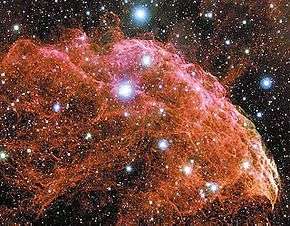 |
IC 443 also known as jellyfish nebulae | ~30,000 years ago | ? | 3000 | II |
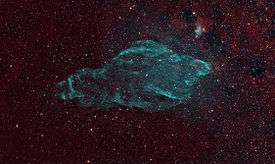 |
W50 or Manatee Nebula |
~20,000 years ago | ? | 18,000 | ? |
 |
Vela SNR | 10,300−9,000 BCE | 12 | 815±98 | II |
 |
Kesteven 79 | 8600-7000 BCE | ? | 23,000 | ? |
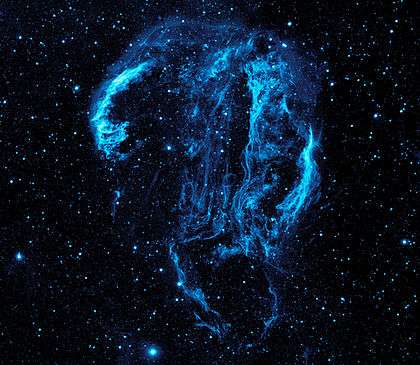  |
Cygnus Loop, including Veil Nebula |
6,000−3,000 BCE | 7 | 1,470 | ? |
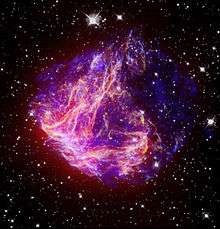 |
LMC N49 | ~3,000 BCE | ? | 160,000 | ? |
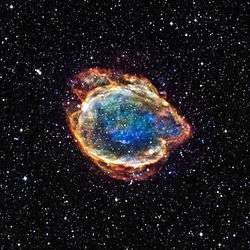 |
G299.2-2.9[1] | ~2,500 BCE | ? | 16,000 | Ias |
 |
Puppis A | ~1,700 BCE | ? | 7,000 | ? |
| G306.3-0.9[2] | ~400 BCE | ? | 26,000 | ? | |
 |
RCW 103 | 1st century | ? | 10,000 | II |
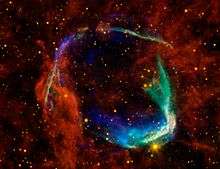 |
SN 185 | December 7, 185 | ? | 8,200 | Ia |
| EO102 | 1st millennium | ? | 190,000 | ? | |
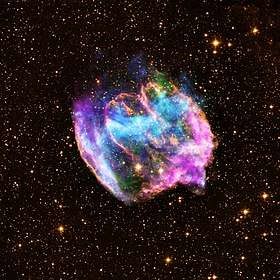 |
W49B | About 1000 AD | ? | 26,000 | Ib or Ic |
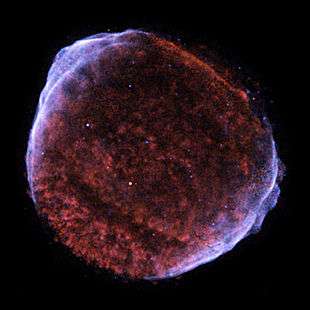 |
SN 1006 | May 1, 1006 | −7.5 | 7,200 | Ia[3] |
 |
SN 1054 or M1 or Crab Nebula |
July 4, 1054 | −6 | 6,300 | II |
.jpg) |
G350.1-0.3 | About 1100 | ? | 15,000 | ? |
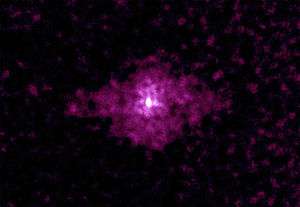 |
SN 1181 | August 5, 1181 | −1 | 26,000 or more | ? |
 |
RX J0852.0-4622 or Vela Junior |
About 1250 | ? | 700 | ? |
 |
SN 1572 or Tycho's Nova |
November 11, 1572 | −4 | 7,500 | Ia[3] |
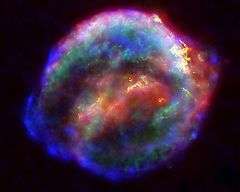 |
SN 1604 or Kepler's Nova |
October 8, 1604 | −2.5 | 20,000 | Ia |
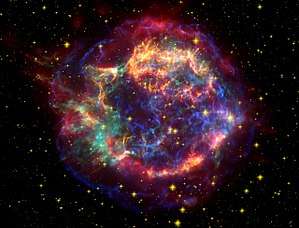 |
Cassiopeia A | Mid 17th century | 6 | 10,000 | IIb[4] |
 |
G1.9+0.3 | About 1868 | ? | 25,000 | Ia |
| SN 1885A or S Andromedae |
August 20, 1885 | 6 | 2,500,000 | ? | |
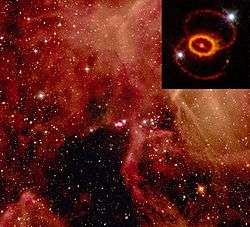 |
SN 1987A | February 24, 1987 | 3 | 168,000 | II-P |
 |
SNR E0519-69.0 | ? | ? | ? | III |
.jpg) |
3C 58 or
SNR G130.7+03.1 |
? | 8.17 | 10,000 | ? |
_(2941492404).jpg) |
DEM L316 | ? | ? | 160,000 | II(large shell) Ia(small shell) |
See also
References
- ↑ Chandra X-Ray Observatory (2015-02-12). "G299.2-2.9: Exploded Star Blooms Like a Cosmic Flower". Retrieved 2015-10-15.
- ↑ Francis, Reddy. "NASA's Swift, Chandra Explore a Youthful 'Star Wreck'". NASA. Retrieved 2013-03-21.
- 1 2 Schaefer, B. E. (2004). Edited by Höflich, Peter; Kumar, Pawan; Wheeler, J. Craig, eds. Cosmic explosions in three dimensions : asymmetries in supernovae and gamma-ray bursts. Cambridge Contemporary Astrophysics. p. 383. ISBN 0-521-84286-7. . Supernovae types discussed in contributed article "Types for the galactic supernovae" by B.E. Schaefer, pages 81–84.
- ↑ Krause, O.; Birkmann, S.; Usuda, T.; Hattori, T.; Goto, M.; Rieke, G.; Misselt, K. (2008). "The Cassiopeia A supernova was of type IIb". Science. 320 (5880): 1195–1197. arXiv:0805.4557. Bibcode:2008Sci...320.1195K. doi:10.1126/science.1155788. PMID 18511684.
External links
- List of all known (extra)galactic supernova remnants at The Open Supernova Catalog.
- Chandra Galactic SNR gallery
This article is issued from
Wikipedia.
The text is licensed under Creative Commons - Attribution - Sharealike.
Additional terms may apply for the media files.
